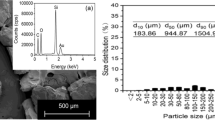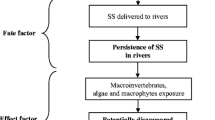Abstract
Purpose
Water from different sources generally contains different kinds of suspended particles, which introduces the challenge of how to control physical clogging during managed aquifer recharge (MAR). Suspended solid concentration (SS) and turbidity (NTU) are widely recognized as indicators of physical clogging potential. The aims of this study were to examine the degree of physical clogging caused by organic and inorganic suspended particles and elaborate the different mechanisms that controlled clogging under specific SS and NTU conditions.
Materials and methods
Column experiments were performed by continuous suspended particle injection through a saturated porous medium under stable physicochemical and hydrodynamic conditions. Three sets of transport tests were carried out. One test was conducted with chlorinated-secondary wastewater (CSW), which SS was 17.59 ± 0.44 mg L−1 corresponding to 3.09 ± 0.05 NTU. The other two tests were silica-particle wastewater (SPW) with the same SS (1.73 ± 0.03 NTU) and the same NTU (29.21 ± 0.57 mg L−1 SS) as the CSW, abbreviated to SPW-SS and SPW-NTU, respectively. The particle breakthrough curves (BTCs), spatial deposition profiles, and variations in hydraulic conductivity were measured. The transport model, DLVO theory, and O’Melia and Ali clogging model were applied to explain the mechanisms of physical clogging in different systems.
Results and discussion
The retention of inorganic particles was greater than that of organic particles; 56.02% of organic particles were retained in CSW, while 87.62 and 86.36% of inorganic particles were retained in SPW-SS and SPW-NTU, respectively. The distribution of organic particles was less uniform than that of inorganic particles. However, the variation of the relative hydraulic conductivity (K/K0) was more significant for organic particles than for inorganic particles, with decreased by just 1.80 ± 0.64% in SPW-SS and 4.03 ± 1.64% in SPW-NTU, but decreased by 85.86 ± 1.22% in CSW. This study explained the results with the support of classical models and the DLVO theory. The physicochemical characteristics of suspended particles determined whether and how physical clogging occurred.
Conclusions
Suspended particles with different properties follow different transport-deposition processes and have different tendencies to cause physical clogging. Especially for organic particles, clogging degree is quite noticeable. Our results imply that the same SS and NTU threshold values cannot be applied to different types of source water during recharge to prevent physical clogging, even in the same controlled environmental conditions. Physicochemical characteristics of suspended particles need to be considered when developing physical clogging indicators.











Similar content being viewed by others
References
Alem A, Elkawafi A, Ahfir ND, Wang HQ (2013) Filtration of kaolinite particles in a saturated porous medium: hydrodynamic effects. Hydrogeol J 21:573–586
Alem A, Ahfir ND, Elkawafi A, Wang HQ (2015) Hydraulic operating conditions and particle concentration effects on physical clogging of a porous medium. Transp Porous Media 106:303–321
Amirtharajah A (1988) Some theoretical and conceptual views of filtration. Journal 80:36–46
Beganskas S, Fisher AT (2017) Coupling distributed stormwater collection and managed aquifer recharge: field application and implications. J Environ Manag 200:366–379
Bekele E, Donn M, Barry K, Vanderzalm J, Kaksonen A, Puzon G, Wylie J, Miotlinski K, Cahill K, Walsh T, Morgan M, McFarlane D, Dillon P (2015) Managed Aquifer Recharge and Recycling Options (MARRO): understanding clogging processes and water quality impacts. Australian Water Recycling Centre of Excellence, Brisbane
Bichara AF (1986) Clogging of recharge wells by suspended solids. J Irrig Drain Eng 112:210–224
Boller MA, Kavanaugh MC (1995) Particle characteristics and headloss increase in granular media filtration. Water Res 29:1139–1149
Bouri S, Dhia HB (2010) A thirty-year artificial recharge experiment in a coastal aquifer in an arid zone: the Teboulba aquifer system (Tunisian Sahel). Compt Rendus Geosci 342:60–74
Bouwer H (2002) Artificial recharge of groundwater: hydrogeology and engineering. Hydrogeol J 10:121–142
Bradford SA, Bettahar M (2006) Concentration dependent transport of colloids in saturated porous media. J Contam Hydrol 82:99–117
Bradford SA, Yates SR, Bettahar M, Simunek J (2002) Physical factors affecting the transport and fate of colloids in saturated porous media. Water Resour Res 38:63-1–63-12
Bradford SA, Simunek J, Bettahar M, Tadassa YF, Van Genuchten MT, Yates SR (2005) Straining of colloids at textural interfaces. Water Resour Res 41:3053–3057
Bradford SA, Torkzaban S, Walker SL (2007) Coupling of physical and chemical mechanisms of colloid straining in saturated porous media. Water Res 41:3012–3024
Camprovin P, Hernández M, Fernández S, Martín-Alonso J, Galofré B, Mes J (2017) Evaluation of clogging during sand-filtered surface water injection for aquifer storage and recovery (ASR): pilot experiment in the Llobregat Delta (Barcelona, Spain). Water 9:263
Crittenden JC, Trussell RR, Hand DW, Howe KJ, Tchobanoglous G (2012) MWH’s water treatment: principles and design, 3rd edn. Wiley, New York
Darby JL, Lawler DF (1990) Ripening in depth filtration: effect of particle size on removal and head loss. Environ Sci Technol 24:1069–1079
Darby JL, Attanasio RE, Lawler DF (1992) Filtration of heterodisperse suspensions: modeling of particle removal and head loss. Water Res 26:711–726
Dillon P (2009) Water recycling via managed aquifer recharge in Australia. Bol Geol Min 120:121–130
Dillon PJ, Hickinbotham MR, Pavelic P (1994) Review of international experience in injecting water into aquifers for storage and reuse. Institution of Engineers, Australia
Dillon P, Pavelic P, Massmann G, Barry K, Correll R (2001) Enhancement of the membrane filtration index (MFI) method for determining the clogging potential of turbid urban stormwater and reclaimed water used for aquifer storage and recovery. Desalination 140:153–165
Du X, Fang Y, Wang Z, Hou J, Ye X (2014) The prediction methods for potential suspended solids clogging types during managed aquifer recharge. Water 6:961–975
Duval Y, Mielczarski JA, Pokrovsky OS, Mielczarski E, Ehrhardt JJ (2002) Evidence of the existence of three types of species at the quartz−aqueous solution interface at pH 0−10: XPS surface group quantification and surface complexation modeling. J Phys Chem B 106:2937–2945
Faber S, Al-Maktoumi A, Kacimov A, Al-Busaidi H, Al-Ismaily S, Al-Belushi M (2016) Migration and deposition of fine particles in a porous filter and alluvial deposit: laboratory experiments. Arab J Geosci 9:293
Fan W, Jiang XH, Yang W, Geng Z, Huo MX, Liu M, Zhou H (2015) Transport of graphene oxide in saturated porous media: effect of cation composition in mixed Na–Ca electrolyte systems. Sci Total Environ 511:509–515
Herzig JP, Leclerc DM, Goff PL (1970) Flow of suspensions through porous media—application to deep filtration. Ind Eng Chem 62:8–35
Huston DL, Fox JF (2015) Clogging of fine sediment within gravel substrates: dimensional analysis and macroanalysis of experiments in hydraulic flumes. J Hydraul Eng 141:04015015
Liu HB, Sun LP, Wang Y, Xia SQ, Le LS (2009) Application of particle-size analysis in coagulation/flocculation for reclamation of a secondary effluent. Water Sci Technol 60:1455–1463
Ma E, Ouahbi T, Wang H, Ahfir ND, Alem A, Hammadi A (2017) Modeling of retention and re-entrainment of mono- and poly-disperse particles: effects of hydrodynamics, particle size and interplay of different-sized particles retention. Sci Total Environ 596:222–229
Mays DC, Hunt JR (2005) Hydrodynamic aspects of particle clogging in porous media. Environ Sci Technol 39:577–584
Mays DC, Hunt JR (2007) Hydrodynamic and chemical factors in clogging by montmorillonite in porous media. Environ Sci Technol 41:5666–5671
Mesticou Z, Kacem M, Dubujet P (2014) Influence of ionic strength and flow rate on silt particle deposition and release in saturated porous medium: experiment and modeling. Transp Porous Media 103:1–24
Mesticou Z, Kacem M, Dubujet P (2016) Coupling effects of flow velocity and ionic strength on the clogging of a saturated porous medium. Transp Porous Media 112:1–18
NRMMC, EPHC, NHMRC (2009) Australian guidelines for water recycling: managing health and environmental risks (phase 2) augmentation of drinking water supplies. Natural Resource Management Ministerial Committee, Environment Protection and Heritage Council, and National Health and Medical Research Council, Australia
O’Melia CR, Ali W (1978) The role of retained particles in deep bed filtration. Prog Wat Tech 10:167–182
Page D, Miotliński K, Dillon P, Taylor R, Wakelin S, Levett K, Barry K, Pavelic P (2011) Water quality requirements for sustaining aquifer storage and recovery operations in a low permeability fractured rock aquifer. J Environ Manag 92:2410–2418
Page D, Vanderzalm J, Miotliński K, Barry K, Dillon P, Lawrie K, Brodie RS (2014) Determining treatment requirements for turbid river water to avoid clogging of aquifer storage and recovery wells in siliceous alluvium. Water Res 66:99–110
Pavelic P, Dillon P, Barry KE, Herczeg Al, Rattray KJ, Hekmeijer P, Gerges NZ (1998) Well clogging effects determined from mass balances and hydraulic response at a stormwater ASR site. In: Third International Symposium on Artificial Recharge, Amsterdam, Holland
Pérez-Paricio A (2001) Integrated modelling of clogging processes in artificial groundwater recharge. Dissertation, Technical University of Catalonia
Pindoria-Nandha M (2016) Planning an aquifer storage and recovery scheme in the Sherwood Sandstone aquifer. Dissertation, Cranfield University
Porubcan AA, Xu S (2011) Colloid straining within saturated heterogeneous porous media. Water Res 45:1796–1806
Redman JA, Walker SL, Elimelech M (2004) Bacterial adhesion and transport in porous media: role of the secondary energy minimum. Environ Sci Technol 38:1777–1785
Rinck-Pfeiffer S, Ragusa S, Sztajnbok P, Vandevelde T (2000) Interrelationships between biological, chemical, and physical processes as an analog to clogging in aquifer storage and recovery (ASR) wells. Water Res 34:2110–2118
Smith L (2014) Clogging mechanisms in managed aquifer recharge: a case study at Mining Area C. Dissertation, The University of Western Australia
Song L, Johnson PR, Elimelech M (1994) Kinetics of colloid deposition onto heterogeneously charged surfaces in porous media. Environ Sci Technol 28:1164–1171
Sultana S, Ahmed KM (2016) Assessing risk of clogging in community scale managed aquifer recharge sites for drinking water in the coastal plain of south-west Bangladesh. Bangladesh J Sci Res 27:75–86
Tobiason JE, Vigneswaran B (1994) Evaluation of a modified model for deep bed filtration. Water Res 28:335–342
Torkzaban S, Brodford SA, Walker SL (2007) Resolving the coupled effects of hydrodynamics and DLVO forces on colloid attachment in porous media. Langmuir 23(19):9652–9660
Tufenkji N, Elimelech M (2004) Correlation equation for predicting single-collector efficiency in physicochemical filtration in saturated porous media. Environ Sci Technol 38:529–536
US EPA (2004) Guidelines for water reuse. US Environmental Protection Agency, Washington
Vigneswaran S, Chang JS (1989) Experimental testing of mathematical models describing the entire cycle of filtration. Water Res 23:1413–1421
Wang Z, Du X, Yang Y, Ye X (2012) Surface clogging process modeling of suspended solids during urban stormwater aquifer recharge. J Environ Sci-China 24:1418–1424
Wu J, Jiang X, Wheatley A (2009) Characterizing activated sludge process effluent by particle size distribution, respirometry and modelling. Desalination 249:969–975
Xu S, Gao B, Saiers JE (2006) Straining of colloidal particles in saturated porous media. Water Resour Res 42:731–741
Xu S, Liao Q, Saiers JE (2008) Straining of nonspherical colloids in saturated porous media. Environ Sci Technol 42:771–778
Yao KM, Habibian MT, O'Melia CR (1971) Water and waste water filtration. Concepts and applications. Environ Sci Technol 5:1105–1112
Yuan J, Dyke MIV, Huck PM (2016) Water reuse through managed aquifer recharge (MAR): assessment of regulations/guidelines and case studies. Water Qual Res J Can 51:357–376
Funding
This study benefited from the financial support of the National Natural Science Foundation of China (NSFC No. 51238001 and 51678121). It was also supported by the scientific and technological development plan project of Jilin Province (No. 20160520022JH).
Author information
Authors and Affiliations
Corresponding author
Additional information
Responsible editor: Yi Jun Xu
Electronic supplementary material
ESM 1
(DOCX 1918 kb)
Rights and permissions
About this article
Cite this article
Wang, Y., Huo, M., Li, Q. et al. Comparison of clogging induced by organic and inorganic suspended particles in a porous medium: implications for choosing physical clogging indicators. J Soils Sediments 18, 2980–2994 (2018). https://doi.org/10.1007/s11368-018-1967-6
Received:
Accepted:
Published:
Issue Date:
DOI: https://doi.org/10.1007/s11368-018-1967-6




